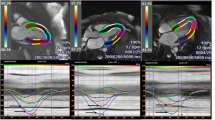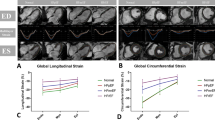Abstract
Cardiac MRI is frequently used in the diagnosis of cardiac amyloidosis. Feature tracking is a novel method of analyzing myocardial strain at the myocardial borders. We investigated myocardial deformation mechanics of both the right and left ventricles in patients with multiple myeloma with suspected cardiac amyloidosis. Comprehensive strain analysis was performed in 43 patients with multiple myeloma and suspected cardiac amyloidosis. MRI strain by feature tracking was measured using 2D cardiac performance analysis MR software (Tomtec, Germany). Global longitudinal (GLS) and global circumferential (GLC) strain were calculated in endo and epicardium. In addition, right ventricular longitudinal strain was measured in the endocardium only. All patients later underwent endomyocardial biopsy. Average wall thickness in biopsy proven cardiac amyloidosis group (22 patients) was 1.4 ± 0.4 cm with wall thickness ≤ 1.2 cm in 36 %. LGE was present in all patients with biopsy confirmed disease. There was significantly decreased global longitudinal strain and strain rate in the epicardial and endocardial layers. Global circumferential strain was significantly reduced in the epicardial layer but not the endocardium. GLS was significantly decreased at the base in both layers compared to the mid and apical regions of the myocardium. However, the base to apex GLS gradient was suggestive of apical sparing in the endocardial layer among patients with amyloidosis (−8.2 ± 2 vs. −2.7 ± 1; p = 0.001) but not the epicardial layer. Apical sparing was evident even in those with normal thickness CA. This feature tracking MRI analysis sheds light on strain mechanics in a cohort of multiple myeloma associated cardiac amyloidosis with a significant number of cases with normal LV wall thickness and explains mechanism of apical sparing effect.


Similar content being viewed by others
References
Bahlis NJ, Lazarus HM (2006) Multiple myeloma-associated AL amyloidosis: is a distinctive therapeutic approach warranted? Bone Marrow Transplant 38(1):7–15
Atrash S, Tullos A, Panozzo S et al (2015) Cardiac complications in relapsed and refractory multiple myeloma patients treated with carfilzomib. Blood Cancer J 5:e272. doi:10.1038/bcj.2014.93
Phelan D, Collier P, Thavendiranathan P et al (2012) Relative apical sparing of longitudinal strain using two-dimensional speckle-tracking echocardiography is both sensitive and specific for the diagnosis of cardiac amyloidosis. Heart 98(19):1442–8
Ternacle J, Bodez D, Guellich A et al (2016) Causes and consequences of longitudinal LV dysfunction assessed by 2D strain echocardiography in cardiac amyloidosis. JACC Cardiovasc 9(2):126–38
Rosen BD, Saad MF, Shea S et al (2006) Hypertension and smoking are associated with reduced regional left ventricular function in asymptomatic: individuals the Multi-Ethnic Study of Atherosclerosis. J Am Coll Cardiol. 47(6):1150–8
Hor KN, Wansapura J, Markham LW et al (2009) Circumferential strain analysis identifies strata of cardiomyopathy in Duchenne muscular dystrophy: a cardiac magnetic resonance tagging study. J Am Coll Cardiol. 53(14):1204–10
Hor KN, Gottliebson WM, Carson C et al (2010) Comparison of magnetic resonance feature tracking for strain calculation with harmonic phase imaging analysis. JACC Cardiovasc Imaging 3(2):144–51
Taylor RJ, Moody WE, Umar F et al (2015) Myocardial strain measurement with feature-tracking cardiovascular magnetic resonance: normal values. Eur Heart J Cardiovasc Imaging 16(8):871–81
Suresh R, Grogan M, Maleszewski JJ et al (2014) Advanced cardiac amyloidosis associated with normal interventricular septal thickness: an uncommon presentation of infiltrative cardiomyopathy. J Am Soc Echocardiogr. 27(4):440–7
Galderisi M, Trimarco B (2015) Speckle-tracking echocardiography-derived longitudinal dysfunction: a novel starting point of the hypertensive patient’s journey toward heart failure. J Am Coll Cardiol 66(21):2472
Di Bella G, Minutoli F, Pingitore A et al (2011) Endocardial and epicardial deformations in cardiac amyloidosis and hypertrophic cardiomyopathy. Circ J 75(5):1200–8
Fontana M, Chung R, Hawkins PN, Moon JC (2015) Cardiovascular magnetic resonance for amyloidosis. Heart Fail Rev 20(2):133–44
Fontana M, Pica S, Reant P et al (2015) Prognostic value of late gadolinium enhancement cardiovascular magnetic resonance in cardiac amyloidosis. Circulation 132(16):1570–9
Brooks J, Kramer CM, Salerno M (2013) Markedly increased volume of distribution of gadolinium in cardiac amyloidosis demonstrated by T1 mapping. J Magn Reson Imaging 38(6):1591–1595
Karamitsos TD, Piechnik SK, Banypersad SM et al (2013) Noncontrast T1 mapping for the diagnosis of cardiac amyloidosis. JACC Cardiovasc Imaging 6(4):488–97
Banypersad SM, Fontana M, Maestrini V et al (2015) T1 mapping and survival in systemic light-chain amyloidosis. Eur Heart J. 36(4):244–51
Foley PW, Hamilton MS, Leyva F (2010) Myocardial scarring following chemotherapy for multiple myeloma detected using late gadolinium hyperenhancement cardiovascular magnetic resonance. J Cardiovasc Med (Hagerstown) 11(5):386–388
Brahmbhatt T, Hari P, Cinquegrani M, Kumar N, Komorowski R, Migrino RQ (2008) Case report: delayed enhancement on cardiac MRI in a patient with multiple myeloma without amyloidosis. Br J Radiol 81(971):e272–e275
Author information
Authors and Affiliations
Corresponding author
Ethics declarations
Conflict of interest
None for all authors.
Ethical approval
All procedures performed were in accordance with the ethical standards of the institutional and/or national research committee and with the 1964 Helsinki declaration and its later amendments or comparable ethical standards. The study was approved by the University of Arkansas for Medical Sciences institutional review board.
Rights and permissions
About this article
Cite this article
Bhatti, S., Vallurupalli, S., Ambach, S. et al. Myocardial strain pattern in patients with cardiac amyloidosis secondary to multiple myeloma: a cardiac MRI feature tracking study. Int J Cardiovasc Imaging 34, 27–33 (2018). https://doi.org/10.1007/s10554-016-0998-6
Received:
Accepted:
Published:
Issue Date:
DOI: https://doi.org/10.1007/s10554-016-0998-6




